Project & Service
Mediation Model
Project Introduction
This system leverages AI technology to accurately analyze legal issues, making the legal consultation process more efficient and personalized. Its primary function is to provide case-specific mediation strategies for involved parties. Users only need to enter questions related to their case, and the software, using a database of 140 million public historical cases and AI algorithms, will deliver insights such as success rate predictions, benefit analysis, and action recommendations. It will also suggest similar cases and reference relevant legal provisions, primarily serving mediators and the disputing parties.
Key Research
· Data Collection and Cleaning: Collect and process large volumes of key data related to public mediation, including mediation cases, legal statutes, judicial interpretations, and legal business data. This data will be cleaned, labeled, and categorized for model training and analysis.
· Model Training and Optimization: Specialize a large language model for public mediation scenarios, designed to process long-text data and extract critical information. The model’s scalability and flexibility are also considered to accommodate various types of mediation cases.
· Enhanced Natural Language Processing: Strengthen the model's ability to understand and generate natural language, facilitating interaction with users. Optimize the language model to accurately interpret the concerns and positions of both parties in mediation.
· Model Performance Evaluation System: Establish a system for periodic evaluation of the model’s effectiveness in practical mediation, with a feedback mechanism to collect user feedback for ongoing improvements.
Outcomes

Application Scenarios and Functions
The primary application scenario for the Mediation Model is with the Public Mediation Committees and the disputing parties. The system includes five main functions: situation analysis, data-driven analysis, action recommendation, similar case suggestions, and relevant legal provisions.
1. Situation Analysis: Analyze favorable and unfavorable aspects of the case for each party, based on historical case data.
2. Data Analysis: Evaluate case-specific success probability, financial gains, and time costs, assisting parties in making informed decisions.
3. Action Recommendations: Provide specific legal action plans to guide parties in handling the case more effectively.
4. Similar Case Suggestions: Recommend similar historical cases to help users understand the case context and potential outcomes better.
5. Legal Provision References: Reference relevant legal statutes based on the case details to provide legal grounds for the parties involved.
Collaboration Model
The Mediation Model is currently in discussions with the Public Mediation Committees, with plans to integrate the model into the mediation process in the future.




